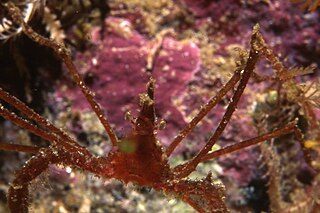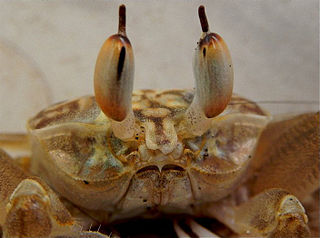
Ghost crabs are semiterrestrial crabs of the subfamily Ocypodinae. They are common shore crabs in tropical and subtropical regions throughout the world, inhabiting deep burrows in the intertidal zone. They are generalist scavengers and predators of small animals. The name "ghost crab" derives from their nocturnality and their generally pale coloration. They are also sometimes called sand crabs, though the name refers to various other crabs that do not belong to the subfamily.

Cancer pagurus, commonly known as the edible crab or brown crab, is a species of crab found in the North Sea, North Atlantic Ocean, and perhaps the Mediterranean Sea. It is a robust crab of a reddish-brown colour, having an oval carapace with a characteristic "pie crust" edge and black tips to the claws. A mature adult may have a carapace width up to 25 centimetres and weigh up to 3 kilograms. C. pagurus is a nocturnal predator, targeting a range of molluscs and crustaceans. It is the subject of the largest crab fishery in Western Europe, centred on the coasts of the British Isles, with more than 60,000 tonnes caught annually.

Ocypode is a genus of ghost crabs found in the sandy shores of tropical and subtropical regions throughout the world. They have a box-like body, thick and elongated eyestalks, and one claw is larger than the other in both males and females. They inhabit deep burrows in the intertidal zone. They are primarily nocturnal, and are generalist scavengers and predators of small animals. The genus contains 21 species.

The Atlantic ghost crab, Ocypode quadrata, is a species of ghost crab. It is a common species along the Atlantic coast of the United States, where it is the only species of ghost crab; its range of distribution extends from its northernmost reach on beaches in Westport, Massachusetts, south along the coasts of the tropical Western Atlantic Ocean to the beach of Barra do Chui, in Rio Grande do Sul in southern Brazil.

Ocypode ceratophthalmus, the horned ghost crab or horn-eyed ghost crab, is a species of ghost crab. It lives in the Indo-Pacific region ; from the coast of East Africa to the Philippines and from Japan to the Great Barrier Reef. They also occur in the Pacific Islands to as far east as Polynesia and Clipperton Island. As their common name implies, O. ceratophthalmus possess eyestalks extending beyond the eyes into long points, which are longer in adults, and shorter in juveniles. The crabs have a box-shaped body, 6–8 centimetres (2.4–3.1 in) across the carapace, with a darker markings towards the rear in the shape of an H. The outer edges of the eye-sheaths are also sharp and broadly triangular and distinctly pointing sideways in larger individuals. O. ceratophthalmus can run at speeds of up to 2.1 metres per second (6.9 ft/s).

Percnon gibbesi is a species of crab. It is one of at least two species commonly called Sally Lightfoot, and is also referred to as the nimble spray crab or urchin crab. It has been described as "the most invasive decapod species to enter the Mediterranean".

Mictyris longicarpus, the light-blue soldier crab, is a species of crab that lives on sandy beaches from the Bay of Bengal to Australia; with other members of the genus Mictyris, it is "one of the most loved crabs in Australia". Adults are 25 mm (1 in) across, white, with blue on their backs, and hold their claws vertically. They feed on detritus in the sand, leaving rounded pellets of discarded sand behind them. The males may form into large "armies" which traverse the beach at low tide, before the crabs dig into the sand to wait for the next low tide.

Ocypode gaudichaudii, also known as the painted ghost crab or cart driver crab, is a species of crab found on Pacific beaches from El Salvador to Chile as well as on the Galápagos Islands. The species was first described by Henri Milne-Edwards and Hippolyte Lucas in 1843.

Achaeopsis spinulosa, the hotlips spider crab, is a species of crab in the family Inachidae, found only around the South African coast. It is the only species in the genus Achaeopsis.

Macropodia falcifera, the Cape long-legged spider crab, is a species of marine crab found around the South African coast. It is a member of the family Inachidae.

Acanthonyx dentatus, the toothed decorator crab, is a species of crab in the family Inachidae.
Hypothalassia acerba is a large crab found in the muddy substrates of the deep seas off the southwestern Australian and New Zealand coasts. Australian distribution, which is correlated to depth and temperature, ranges from a latitude as far north as approximately 27° S on the west coast, southwards, then eastwards on the south coast to a longitude of at least 129° E. The species usually occurs in waters with temperatures of 13–19 °C (55–66 °F) and in depths ranging of 200–255 metres (656–837 ft) on the lower west coast and 90–200 m (300–660 ft) on the south coast. Body size is inversely related to depth of water. There are only two species in the genus Hypothalassia, and H. acerba is not the same champagne crab as the other Hypothalassia species, H. armata, which is found in Japanese waters.

Ocypode cursor, the tufted ghost crab, is a species of ghost crab found on sandy beaches along the coasts of the eastern Atlantic Ocean and eastern Mediterranean Sea.

Trapezia rufopunctata is a species of guard crabs in the family Trapeziidae.

The pink hermit crab is a species of hermit crab in the family Diogenidae.

The gulf ghost crab, Hoplocypode occidentalis, is a species of ghost crabs native to the Pacific coast of the Americas, from the Gulf of California to Colombia. It is the only species in the genus Hoplocypode. Gulf ghost crabs are medium-sized, reaching a maximum overall body diameter of 6 in (15 cm). They are one of only two ghost crab species found in the eastern Pacific. However, gulf ghost crabs can easily be distinguished from painted ghost crabs by the absence of "horns" on their eyes.

Ocypode africana, commonly known as the African ghost crab, is a species of ghost crabs native to the eastern Atlantic coast of western Africa, from Mauritania to Namibia. They are medium-sized ghost crabs reaching carapace width of 3.4 cm (1.3 in). They can vary in coloration from pinkish to dark grey. They are one of only two ghost crab species found in the eastern Atlantic. However, African ghost crabs can easily be distinguished from tufted ghost crabs by the absence of long tufts of hair on the tip of their eyestalks.

Ocypode brevicornis is a species of ghost crab native to the Indian Ocean, from the Gulf of Oman to the Nicobar Islands. They are relatively large ghost crabs with a somewhat trapezoidal body. The carapace reaches a length of 41 mm (1.6 in) and a width of 50 mm (2.0 in). They are a mottled brown to yellow in coloration. Like other ghost crabs, one of their claws is much larger than the other. Their eyestalks are large and elongated, tipped with prolongations at the tip known as styles. They are common inhabitants of open sandy beaches, living in burrows in the intertidal zone.

Ocypode convexa, commonly known as the golden ghost crab, or alternatively the western ghost crab or yellow ghost crab, is a species of ghost crabs endemic to the coast of Western Australia, from Broome to Perth. They are relatively large ghost crabs, with a carapace growing up to 45 mm (1.8 in) long and 52 mm (2.0 in) wide. They are easily recognisable by their golden yellow colouration. Like other ghost crabs they have box-like bodies with unequally sized claws. They also have large eyestalks with the cornea occupying most of the bottom part.

















